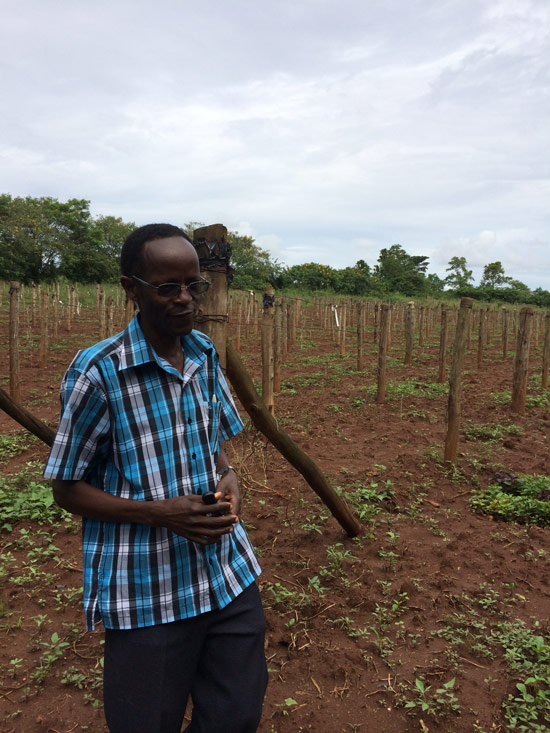Robert was the driving force behind changing the government’s position on sweetpotato, making sweetpotato a research priority in the country, largely replacing white sweetpotato with beta-carotene-rich OFSP, and disseminating strong OFSP varieties throughout east and central Africa. Large populations of east and central Africa would not have access to the benefits of OFSP had it not been for Robert’s research, mentoring, and persistence for the past three decades.
When Robert returned from his Master’s work at the University of the Philippines at Los Banos in 1986 he established the Roots and Tuber Crops Program at the Namulonge research facility. At the time, the Ugandan Ministry of Agriculture (UMA) had deprioritized sweetpotato in favor of other crops, despite the fact that sweetpotato was a major part of the Ugandan diet. The opportunity to use sweetpotato and particularly OFSP to fight VAD did not escape Robert. He and the CIP representative in Nairobi, Peter Ewell, requested UMA to support sweetpotato by developing a separate research program for it. This successful request opened the door to research funding that enabled the release of improved OFSP varieties in Uganda and central and east Africa.
Robert began his research and simultaneously began training and mentoring staff to further this research. The focus on sweetpotato breeding in Uganda resulted in a strong research team at Namulonge with regional on-job training for technicians and scientists. Sweetpotato breeders and technician from 10 countries in Sub-Saharan Africa came to Robert’s program for week to month long workshops devoted to improving sweetpotato breeding skills. By 2009, when Robert joined CIP, Namulonge was the sweetpotato support platform for East and Central Africa due to Robert’s investment in developing infrastructure and staff over the years.
Including OFSP in the farming and food systems began in Central Uganda in 1999 as a joint multi-sectoral effort involving over 15 different partners. Robert and his team conducted rapid on-station and on-farm trials of introduced and local OFSP germplasm that led to the official release of the Kakamega and Ejumula varieties in 2004 for deployment by the projects and consumption by communities. Since then Robert has developed 12 new varieties, including the high-provitamin A (b-carotene) OFSP. Some of these released varieties have gained importance regionally.

In the 1990s, CIP introduced OFSP approximately 200 clones as in vitro plantlets to collaborating SSA countries. In Uganda, Robert evaluated the received OFSP in different agroecologies. The clones were either not adapted to the growing conditions or were not suitable for local consumption; they had low dry matter content (DMC); were susceptible to diseases, especially Alternaria bataticola blight, and sweetpotato virus disease (SPVD), the most devastating disease to sweetpotato in SSA. Robert worked on a short-term goal of testing local varieties and introduced germplasm, releasing adapted varieties, and used crossing schemes in crossing blocks at Namulonge that included OFSP clones from various sources around the globe. The raw materials (the genes) for improving OFSP were sought from non-orange sweetpotato germplasm. The schemes had medium to long term goals which aimed at finding solutions to the major sweetpotato production constraints, namely, the major diseases mentioned earlier and sweetpotato weevils that cause up to 100% yield loss in highly susceptible cultivars during dry periods. As a further challenge, Robert had to combine these desirable traits with high b-carotene content in the same genetic background.
Robert succeeded in breeding for virus resistance, made considerable progress in understanding the underlying genetics of virus resistance, and also managed to incorporate the high dry matter content that people liked. He also started work with various teams to understand better the molecular and genetic basis for field resistance to viruses to enable more accurate and targeted breeding strategies to achieve high levels of resistance in progeny populations. Although to date there are no cultivars with durable field resistance under high weevil populations, Robert and his team have made some progress by broadening the sources of weevil resistance through local collections and screening for resistance. Specifically, the team identified hydroxycinnamic acid esters as the biochemical basis for sweet potato weevil resistance in the New Kawogo sweetpotato landrace he released.
Robert’s successes have been shared throughout the region. His program generated breeding populations (seed), which he sent to Burundi, Ethiopia, Rwanda, Kenya, Tanzania, Madagascar, Ghana, Nigeria, Malawi, Mozambique, Zambia, South Africa, and Burkina Faso. In 2007, 261,980 seeds were sent to these countries, representing about 40% of the seed produced by Robert’s program.
